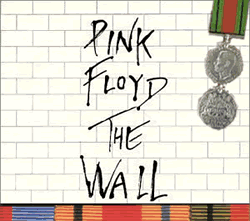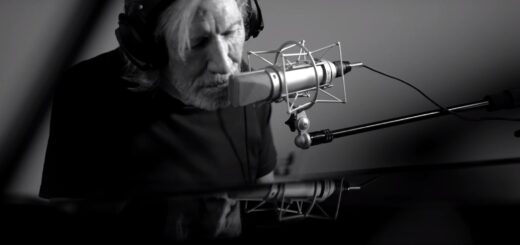A Requiem For The Post-Wall Dream By Sean Ellis (mosespa)
 |
| A mock-up of what The Wall could have been… according to David Gilmour! |
It is often said that The Final Cut is “simply left-overs from The Wall.” This misconception (as I am about to demonstrate this notion to be,) often seems to stem from one of two places:
1. A comment in the book A Saucerful Of Secrets: The Pink Floyd Odyssey by Nicholas Schaffner in which David Gilmour is quoted as saying “…songs that we threw off The Wall, he (Waters) brought them back for The Final Cut–same songs. Nobody thought they were that good then; what makes them so good now?”
2. The fact that at one time, The Final Cut was originally intended to be either the soundtrack to the film of The Wall, or an album of songs that were re-recorded especially for the movie (such as Mother, Goodbye Blue Sky and both versions of In The Flesh.)
I’ll deal with point 2 first, as it is the easiest to dismiss. Yes, there WAS supposed to be an album of film music…yes, “When The Tigers Broke Free” was supposed to be included (as a single release at the time announced.) No, The Final Cut did not arise from that.
What seems to have happened is this: Pink Floyd had an upcoming obligation to produce an album. A soundtrack to The Wall seemed to be the thing to do…however, much of the music in the movie was taken directly from the original album, so it would basically have been a re-release of the album with only a handful of “new” material. So, it was decided to scale it down to only songs that had been re-recorded specifically for the film. This seemed satisfactory…but then, the Falklands Conflict happened.
Roger Waters had spent the years from 1978 to 1982 (four years, for anyone counting,) working exclusively on a piece in which the death of his own father figured quite heavily. Eric Fletcher Waters died in World War Two (which was also called The War To End All Wars), which was supposed to have brought permanent peace and prosperity to the world.
The Falklands Conflict drove the point home to Roger Waters that this peace and prosperity had failed to have been brought about…ergo, his father’s sacrifice (and the sacrifice of so many others) appears to have been in vain. Roger Waters started writing a piece that dealt with these feelings. Yes, it’s about his father’s death and so is The Wall…but so is Free Four from Obscured By Clouds.
You don’t hear people claiming The Wall to have been made up of ideas that were rejected for Obscured By Clouds.
Which brings me into the task of explaining away point One…Gilmour’s assertion that Roger was bringing back songs that had been thrown off of The Wall.
First, let’s make it clear that Gilmour only says “…songs that we threw off The Wall, he brought them back for The Final Cut…” which seems to imply that The Final Cut was already being worked on as it’s own piece when Roger started bringing these wayward songs back in.
Nowhere does Gilmour say that The Final Cut is NOTHING BUT things thrown off of The Wall. In fact, the Schaffner book only names TWO songs from The Final Cut which were apparently once part of The Wall. Those two songs are “Your Possible Pasts” and “The Hero’s Return.”
But perhaps the strongest piece of evidence is in the new Vernon Fitch/Richard Mahon book “Comfortably Numb; A History Of The Wall.” In this book, Fitch (who is the curator of The Pink Floyd Archives,) is kind enough to present the track listing for Roger Waters’ ORIGINAL HOME MADE demo of “Bricks In The Wall” (as it was called at the time.) This track listing reveals only ONE song which became part of The Final Cut. “Teacher, Teacher” ended up becoming “The Hero’s Return.”
There are no other songs on this demo that indicate anything which ended up on The Final Cut. I found it interesting that at one time “Sexual Revolution” was part of The Wall…but you don’t hear people screaming that The Pros And Cons Of Hitch Hiking is nothing but leftovers from The Wall. Which is really funny because both PACOHH and TFC have the exact same number of songs that got tossed from The Wall:
One.
That’s IT.
One song each.
It’s quite possible that Gilmour was being hyperbolic. Perhaps he only meant to say “one song,” or perhaps he felt that it was necessary to make it sound like more than one song just to make it seem like a better point. Perhaps what we REALLY should do is just go through the lyrics for the whole thing…but that would take too long. Instead, I’ll take it as read that everyone reading this has access to the same copy of the lyrics posted here at NPF as I do; and we’ll just sort of glance over each track on the album and see if there’s any way it COULD have fit into The Wall in the first place.
A Song-By-Song Analysis
1. The Post-War Dream: At first glance, it’s easy to imagine the singer of this song as being the Pink of The Wall. He wants to know why his daddy died, he apparently watches a lot of television, he blames the problems of the world on others instead of seeing his own part in them. Sure, these are themes from The Wall…but aren’t they also themes from the day to day life of just about any person born during/after WWII? The references to the building of ships and the suicides of Japanese children seems to have more to do with the early 1980’s than with the 1940’s…and since The Wall was written in 1978, it seems safe to assume that this particular song was never part of The Wall.
2. Your Possible Pasts: Ah…now THIS is a song we hear Pink mumbling lyrics from in the movie version of The Wall…but that doesn’t mean that this song was once part of that album. Pink is also heard mumbling lyrics from The Moment Of Clarity, which seems to have never been part of The Wall, either. This theme of this song’s lyrics seems to be the importance of learning from the mistakes of the past, lest one be doomed to repeat them. This would tie very neatly in to the idea that The Falklands Conflict expressly shows that the lessons of WWII have not been learned. Since The Wall predates The Falklands Conflict, it seems safe to assume that this song was never part of The Wall, either.
3. One Of The Few: This song sets up the character of a WWII serviceman who has turned to teaching as a means of earning his keep. There is a certain ominous undertone to the way the character looks at his responsibility of shaping these young lives; the fact that every option begins with the phrase “make them” indicates that the teacher believes that his job is to control these young minds instead of actually teaching them. What at first seems to be a slightly more sympathetic view of teachers (perhaps even The Schoolmaster himself,) ends up only deepening the sinister quality of the character. It is possible that this song could once have been part of The Wall…but only if there were a subplot involving the life of The Schoolmaster showing how his own wall contributed to Pink’s. There is no record of this song having ever been part of The Wall, however.
4. The Hero’s Return: This song is noted as having once been part of The Wall. However, Fitch only notes that the MUSIC of the song (called “Teacher, Teacher” at the time of The Wall) went on to become this song. It’s possible that when it was part of The Wall, there was a completely different set of lyrics. Given that this song’s place in The Wall fell in between ABITW Part Two and Young Lust, it would seem that this song was just further elaboration on the perils Pink encountered in the educational system himself, rather than any sort of exploration into The Schoolmaster’s life.
5. The Gunner’s Dream: Dealing with the death of a serviceman and how the life of those he’s left behind is impacted, this tune doesn’t seem to have anyplace to fit within The Wall. Again, this song references the Post War Dream of peace and prosperity which manifestly failed to come to pass after WWII…which suggests that the lives of all the men who died in WWII were given in vain. The event which underscored for Waters the pointlessness of these deaths was, again, The Falklands Conflict which is predated by The Wall. So, it would seem safe to assume that this song was also never part of The Wall.
6. Paranoid Eyes: Following the surviving serviceman’s rather dreary life as he essentially slowly drinks himself to death underscores the failure of the Post War Dream to manifest. As The Wall predates the Falklands Conflict which brought this realization home to Waters, it’s safe to assume that this song was never part of The Wall.
7. Get Your Filthy Hands Off My Desert: This song specifically mentions Galtieri’s occupation of the Falkland Islands which set the Falklands Conflict into motion. This song was clearly never part of The Wall.
8. The Fletcher Memorial Home: In it’s musical and lyrical tone, this song would seem to be right at home on The Wall, somewhere between Vera and Bring The Boys Back Home. However, it’s mention of political figures who didn’t come into prominence on the world stage until after The Wall (as well as the specific reference of “a group of Latin American meat packing glitterati,”) indicates that it was written after The Wall.
9. Southampton Dock: It seems clear that the woman waving goodbye from the dock is Margaret Thatcher. It is also clear that the boys she is waving goodbye to are young men off to die in the Falklands. Once again, the betrayal of the Post War Dream is mentioned and by now, it should be clear that the event which drove this idea home to Waters was the Falklands Conflict…and since The Wall predates the Falklands Conflict, it’s quite safe to assume that this song was never part of The Wall.
10. The Final Cut: Now HERE is a song that seems to take much of Pink’s history and sum it all up in one neat little package. The lyric “making love to girls in magazines” even seems to fit with Waters statement that Young Lust was originally about hanging around porno shops being very interested in sex, but too afraid to get involved. It seems to be all about someone’s life falling apart due to the ending of a relationship. It’s certainly about the barriers that people put up which keep them from connecting with other people. It displays the fear and apprehension a person with an intact wall feels at the idea of letting someone see what’s behind their wall. It even seems possible that this song may have been the denoument to The Wall at one time. Pink has bared his naked feelings to someone and it has proven more than he could bear…he is about to end it all when, suddenly, someone reaches out to make contact with him. It seems possible that this song might once have been part of The Wall, but there is no documentation to suggest this.
11. Not Now John: In dealing almost entirely with the military/industrial complex and the effects it is having on the “average Joe,” this song’s lyrics seem firmly rooted in the zeitgeist of the early 1980’s. Thatcher is referenced, the film version of The Wall is referenced (which alone makes this song a most unlikely candidate for having ever been part of The Wall,) and the reference of the fact that Britain “showed Argentina” firmly lock this song in coming after The Wall. Hence, it could never have been a part of it.
12. Two Suns In The Sunset: A song about the final nuclear annhiliation of everything doesn’t really seem to fit anywhere within the storyline of The Wall. For that alone, it seems safe to assume that this song was never a part of The Wall.
A Final Thought
So, with only three out of twelve songs (one-quarter of the album) showing signs that they might have once been a part of The Wall, it seems ridiculous to trivialize the remaining three-quarters of an album by saying that the album is simply made up entirely of rejects from a previous album.
Clearly, it isn’t.
The Final Cut may contain a few songs which were thrown off The Wall, but those few songs don’t constitute the entire album. In fact, as demonstrated above, they only constitute a quarter of the album at best.



